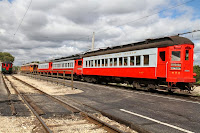Today it was time to start working on the roof of the 319 in earnest. Located where it is now, I can move the scaffold up and down the aisle, and access the lower part of the roof on one side easily. I estimated it would take a day to remove the lower canvas, the lower tack molding, and perhaps the upper tack molding too.

Here's what it looks like before we start. Not bad, if you don't look too close. But the upper edge of the lower canvas is held on with very few tacks, and not sealed where it meets the clerestory deck.

And I had noticed this before, but the lower edge was attached by inserting a tack every 6" or so from inside, and then folding the canvas up over it. I cannot imagine why this was thought a good idea. As a result, the canvas came off way too easily.

Just pull it a little by hand, and it separates from the rotten tack molding.
That goes along fine until we run into this big ugly thing. The ventilator was never removed during the canvas job, and you will notice the flanges are not tacked down, etc. The new canvas was just installed around it. They must have really been in a hurry.
Now here's something I actually like. A thin molding strip was installed along the upper edge, caulked, and fastened with nails and screws. I will probably want to do something like this. The problem is that it was only installed for about 12 feet. You have to wonder why.
The canvas itself was not in bad shape, and we may find a use for it later. So it was rolled out (here it's upside down) to check for tacks, then rolled up and stored.

That went quickly. Then I started working my way back west, removing both the lower and upper tack moldings. The lower tack molding was very rotten, split almost its entire length, and came off easily, but the letterboard to which it's attached seems to be good.. The upper tack molding wasn't much better, but the wooden rail to which it's attached will need to be replaced.
But a job I had estimated to take a day needed less than four hours. I suppose we should count ourselves lucky the roof held together as long as it did. On the top, especially, in many sections the canvas was keeping the tack molding in place, rather than vice versa. Be that as it may, it's always nice when progress is being made.
However, looking down, it appears I must have accidentally dropped a few pieces of wood and what not on the sidewalk. And I'm afraid Dave Diamond may not approve. They say he has very little tolerance for things like this. Fortunately it doesn't take long to pick up and sweep up everything and deposit it in the nearby dumpster. Then I worked on the 36 some more, and then started removing the rail behind the upper tack molding. That has to be done carefully, so progress is slower.
Meanwhile, a contractor was repainting the Great Northern tank car. The light grey color is the epoxy primer, and the finish coat is black. This was taken about 2 PM.
Progress is rapid By about 3:30, most of the first finish coat is on.

And shortly after that, they're nearly done.
It's not often you can see your reflection in the side of a tank car. It's like an amusement park mirror!











































.JPG)




.JPG)



.JPG)



.JPG)
.JPG)









